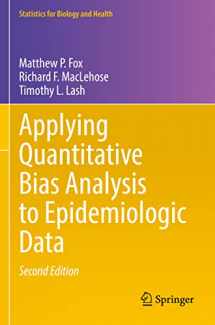
Applying Quantitative Bias Analysis to Epidemiologic Data (Statistics for Biology and Health)
Book details
Summary
Description
Bias analysis quantifies the influence of systematic error on an epidemiology study’s estimate of association. The fundamental methods of bias analysis in epi- miology have been well described for decades, yet are seldom applied in published presentations of epidemiologic research. More recent advances in bias analysis, such as probabilistic bias analysis, appear even more rarely. We suspect that there are both supply-side and demand-side explanations for the scarcity of bias analysis. On the demand side, journal reviewers and editors seldom request that authors address systematic error aside from listing them as limitations of their particular study. This listing is often accompanied by explanations for why the limitations should not pose much concern. On the supply side, methods for bias analysis receive little attention in most epidemiology curriculums, are often scattered throughout textbooks or absent from them altogether, and cannot be implemented easily using standard statistical computing software. Our objective in this text is to reduce these supply-side barriers, with the hope that demand for quantitative bias analysis will follow.


We would LOVE it if you could help us and other readers by reviewing the book
Book review



